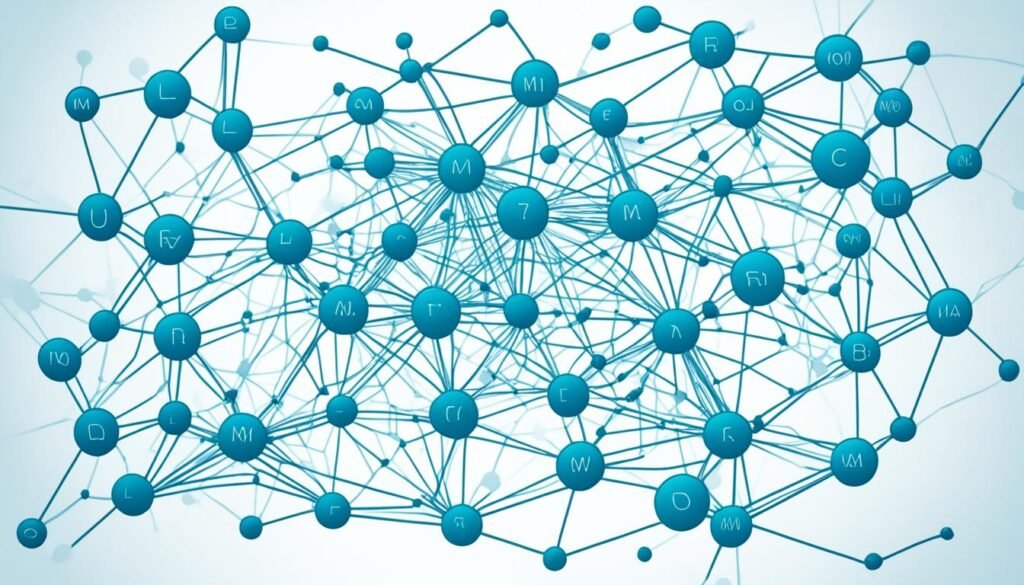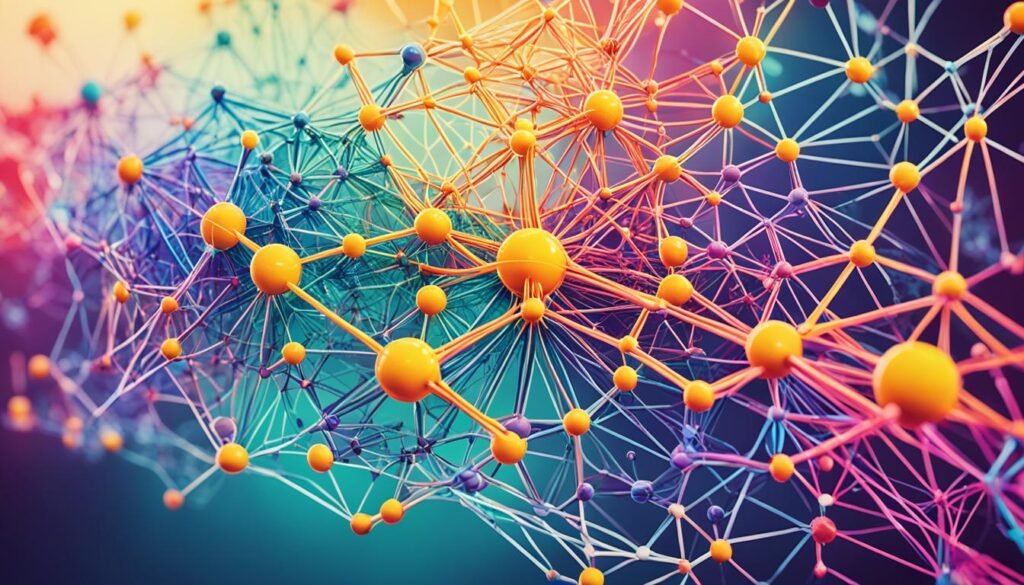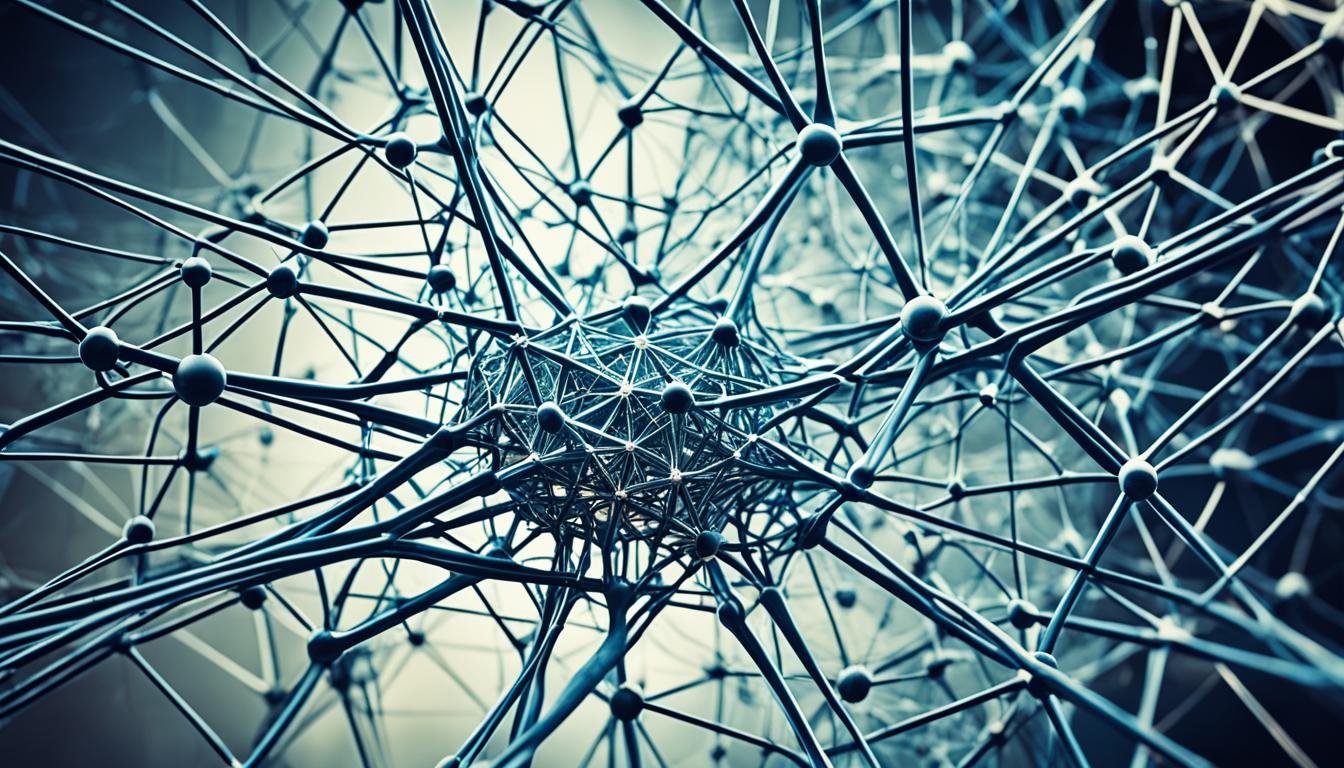Did you know an AI system can check over 10,000 financial transactions in seconds to spot fraud? This shows how Artificial Intelligence (AI) is changing the world. At its core, Machine Learning (ML) lets machines learn from data and spot patterns, similar to how a child learns to tell cats from dogs.
Neural Networks, modeled after the human brain, are key to AI’s smart choices. These networks are made up of layers of neurons that work together to understand information and make complex decisions. Deep Learning goes even further, finding hidden patterns in data, which powers tech like voice assistants and self-driving cars.
Key Takeaways
- Machine Learning enables machines to learn from data and improve performance over time.
- Neural Networks mimic the human brain’s processing to perform tasks with remarkable accuracy.
- Deep Learning uses neural networks to identify complex patterns in data, powering advanced AI applications.
- AI systems can analyze vast amounts of data in real-time, making them invaluable in industries like finance and transportation.
- Understanding how AI learns is the key to unlocking its full potential and shaping the future of technology.
The Magic of Machine Learning
Machine learning (ML) is key to artificial intelligence. It lets machines learn from data and get better over time. At its core are neural networks, like the human brain, with layers of neurons that process information. This helps machines spot complex patterns and make smart choices.
Neural Networks: Mimicking the Human Brain
Neural networks copy how our brains process info. They have nodes, or “neurons,” that work together to find patterns, predict outcomes, and solve problems. The more data it gets, the better it makes decisions, just like our brains do.
Deep Learning: Diving Deeper into Data
Deep learning is a part of machine learning that goes deeper. These networks have many hidden layers to explore data deeply and find complex patterns. This tech is behind many advanced AI tools, like voice assistants and self-driving cars.
Together, machine learning, neural networks, and deep learning have opened a new era of smart systems. They can solve tough problems fast and accurately. As these techs grow, how we use AI will change in big ways.
| Machine Learning Technique | Description |
|---|---|
| Supervised Learning | The algorithm learns from labeled data, making predictions and adjusting based on feedback. |
| Unsupervised Learning | The algorithm discovers patterns and insights from unlabeled data without guidance. |
| Reinforcement Learning | The algorithm learns through trial and error, receiving rewards or penalties based on its actions. |
Machine learning is always getting better, opening up new possibilities. It’s changing how we use natural language and see the world.

“Machine learning is the future, not only for Russia, but for all humankind… It comes with colossal opportunities, but also threats that are difficult to predict. Whoever becomes the leader in this sphere will become the ruler of the world.”
– Vladimir Putin
Natural Language Processing: Bridging Human and Machine Communication
Natural Language Processing (NLP) is the key to making humans and machines talk smoothly. It lets machines understand, interpret, and create human language. This tech is behind the chatbots and virtual assistants that have changed how we talk to computers.
NLP uses many techniques like tokenization, syntax analysis, and semantic understanding. These help machines understand language, its meaning, and even the feelings behind words. This mix of language, stats, and learning has changed how we use AI.
NLP touches many areas and uses. Virtual assistants like Siri, Alexa, and Google Assistant use NLP to understand what we say and answer us clearly. Chatbots use NLP for conversations that feel like talking to a person, making customer service better.
NLP does more than just chat. It helps translate languages in real-time, making global talks easier. It also makes search engines give us better results by understanding what we’re looking for. Plus, it can summarize big texts, find important info, and analyze feelings, changing how we use and understand data.
“Natural Language Processing is the future of human-machine interaction, unlocking new possibilities in communication, information processing, and automation.”
NLP is getting better all the time, opening up more ways to use it. It can make customer experiences better and help businesses run smoother. As we explore this new area, combining human language with machine smarts will bring new levels of understanding, efficiency, and innovation.

| NLP Application | Key Benefits |
|---|---|
| Conversational AI (Chatbots and Virtual Assistants) | Improved customer experience, scalable support, 24/7 availability |
| Machine Translation | Accurate, context-aware language translation for global communication |
| Document Management | Text summarization, information extraction, and classification |
| Content Generation | Automated creation of unique, engaging content |
| Speech Recognition | Accurate conversion of spoken language to written text |
| Sentiment Analysis | Insights into customer opinions and online reputation management |
| Search Engine Optimization (SEO) | Improved search result relevancy by understanding user intent |
Computer Vision: Seeing the World Through AI
Imagine a world where machines can see, understand, and interpret the visual world around them. That’s the power of computer vision. This technology lets computers analyze and understand digital images and videos. It’s like giving them a pair of eyes.
Computer vision is changing many industries. It helps with facial recognition and automated health diagnoses from scans. Thanks to deep learning and big datasets like ImageNet, this field has grown a lot.
Robotics: The Physical Extension of AI
Robotics takes AI’s “sight” a step further by adding physical machines. These robots can do everything from making cars to flying drones with packages. They combine AI’s intelligence with mechanical engineering.
- The computer vision market is expected to hit USD 48.6 billion by 2022, showing its growing importance.
- Convolutional Neural Networks (CNNs) now perform as well as humans in many tasks, like recognizing images and detecting objects.
- Computer vision has many uses, from self-driving cars and surveillance to medical imaging and virtual reality.
As these technologies get better, we face big ethical questions. We need to think about privacy, bias, and who’s responsible. It’s important to handle these issues as computer vision and robotics become more common in our lives.
“Computer vision is the science and technology of machines that can see. As a scientific discipline, computer vision is concerned with the theory behind artificial systems that extract information from images.”

How AI Learns: Unraveling the Process
AI’s journey to learn and get better is really interesting. It uses three main ways to learn: Supervised Learning, Unsupervised Learning, and Reinforcement Learning. These methods help AI systems get better at what they do.
Supervised Learning: Teaching with Examples
Supervised Learning is like a kid learning to tell cats from dogs. The AI gets shown examples, like pictures of cats and dogs, with labels. It then learns to spot the differences, so it can tell new pictures apart.
This kind of training is used a lot in things like recognizing images, understanding language, and predicting things. The more labeled data the AI sees, the better it gets. This makes it really useful for many tasks.
Unsupervised Learning: Finding Patterns
Unsupervised Learning lets the AI find patterns on its own, without labeled data. It’s great for complex, messy data like customer habits, social media, or market trends.
Algorithms like clustering and anomaly detection help the AI find hidden patterns and relationships in data. This can reveal new insights and lead to innovation.
Unsupervised Learning helps AI find things we might miss and gives us new insights. It’s key to how AI learns and improves.

“The beauty of machine learning is that it allows us to build systems that can learn from data, identify patterns, and make predictions without being explicitly programmed.” – Andrew Ng, Co-founder of Coursera and former Chief Scientist at Baidu
Model Optimization: Refining AI Performance
Optimizing AI models is key to making them work better and give accurate results. Techniques like transfer learning help by using knowledge from one task to improve another. This makes AI systems learn faster and do more.
Transfer Learning: Leveraging Prior Knowledge
Transfer learning is a big deal in machine learning and deep learning. Instead of starting over, AI models use what they’ve learned before. This helps them tackle new tasks faster and with less effort.
- In AI model optimization, strategies such as retraining on better data can lead to models equipped with current information, enabling more accurate predictions and adaptability to changing scenarios.
- Deployment modification involves adjusting the operating environment, suggesting changes in hardware like enhanced processors or GPUs, as well as optimizing software environments for improved performance.
- Source code enhancements, such as parallel computing and specialized hardware accelerators like GPUs, can significantly speed up AI model training and inference processes, resulting in faster and more reliable models.
By using transfer learning, AI models can use what they already know. This means they don’t need to start over, which saves time and makes them work better. This is especially useful when data is hard to get or not much is available.
“Transfer learning is a game-changer in the world of AI. By allowing models to reuse knowledge, it accelerates their ability to adapt and thrive in new environments.”
The importance of optimizing AI models and using techniques like transfer learning will keep growing. These methods help AI systems learn and adapt quicker. This opens up new possibilities in machine learning and deep learning.
AI Ethics and Bias: Navigating the Moral Compass
AI is becoming a big part of our lives, so we must think about its ethics and biases. Like storytellers, AI makers need to make sure their work is fair and clear. They should not add to society’s biases. This means AI and humans can move forward together, respecting privacy and being accountable.
One big issue with AI is algorithmic bias. This happens when AI systems learn from data that shows old prejudices. For instance, some facial recognition AI sees race as a bias, and AI in hiring can be sexist.
To fix this, AI developers focus on fairness and transparency. They use diverse data and check their AI often to lessen bias. They also use special methods to change algorithms and reduce bias.
Accountability is key in AI too. When AI makes mistakes, it’s hard to say who should be blamed. We need rules and groups that include many people to help make AI right.
| Key Aspect | Percentage of Concern |
|---|---|
| Transparency in AI | 58% |
| Discriminatory effects of AI | 42% |
| Data privacy in AI applications | 78% |
| Prioritizing societal impact in AI | 64% |
| Ethical guidelines for AI development | 87% |
| Collaborative engagement in ethical AI | 71% |
| Importance of ethical AI principles | 79% |
As AI grows, we must work together to make sure it’s used right. By focusing on fairness, transparency, and accountability, we can guide AI to help everyone.
“AI developers must ensure their creations are fair, transparent, and do not perpetuate societal biases.”
Applications of AI: From Virtual Assistants to Self-Driving Cars
Artificial intelligence (AI) goes far beyond what we thought possible. It ranges from virtual assistants that listen to our voice to self-driving cars on the road. This kind of intelligence, called narrow AI, is made to be great at certain tasks. It shows how powerful machine learning and deep learning can be.
Virtual assistants like Siri and Google Assistant use natural language processing to get what we say. They can plan our day, remind us, and control our smart devices with just a voice command. Self-driving cars use computer vision and deep learning to see and understand the world. This makes driving without a human possible.
Narrow AI: Specialized Intelligence in Action
Narrow AI, or specialized intelligence, is about AI for specific jobs. These jobs include things like making recommendations, finding fraud, and recognizing images. AI shows its strength and problem-solving skills in many areas. In healthcare, AI helps analyze medical images to spot diseases early and accurately. In finance, AI finds fraud to protect money and assets. In education, AI tailors learning to each student’s needs.
The car industry is really taking to AI. Cars now have voice-activated features so drivers can make calls, send messages, or adjust settings without using their hands. BMW’s i Vision Dee technology even lets drivers connect with the metaverse from inside the car, mixing the real and digital worlds.
| AI Application | Industry | Key Benefit |
|---|---|---|
| Medical Image Analysis | Healthcare | Early disease detection |
| Fraud Detection | Finance | Protecting customer assets |
| Personalized Learning | Education | Enhancing student experience |
| Voice-Activated Features | Automotive | Hands-free driving |
As AI keeps getting better, we can expect even more amazing things. Car makers are looking into adding virtual assistants powered by advanced language models like OpenAI’s ChatGPT. This could change how we talk to our cars. The future looks bright, and AI’s impact on our lives is just starting.
“The integration of AI in the automotive industry is not just about making cars smarter, but about transforming the entire driving experience.”
The Future of AI: Possibilities and Challenges
The future of artificial intelligence (AI) is full of both exciting chances and big challenges. We see AI making huge strides in specific tasks. Yet, the idea of General Artificial Intelligence (AGI) – machines as smart as humans – keeps us excited and talking.
Generative AI is now creating new content like text, images, and music. This shows how machines can be creative. These AI tools are changing many industries. They’re making customer experiences better, improving supply chain management, and changing how we diagnose health issues.
But, as AI grows, we face tough ethical questions and concerns. We need to make sure AI is made and used right. This means looking at data privacy, fairness in algorithms, and how AI might change jobs.
A 2023 IBM survey found 42% of big companies use AI, and 40% are thinking about it. Also, 38% use generative AI, and 42% are looking into it. This shows more automation in many fields soon.
Despite the big chances with future AI, there are big challenges. Making and keeping AI might increase carbon emissions by 80%. Women are also facing a gap in AI skills, making them more likely to lose jobs to AI.
To make the most of AI, we need to work together. This means efforts from everyone, from policymakers to industry leaders and researchers. By tackling these issues, we can make sure AI’s benefits go to all and its risks are managed well.
“AI is critical to our success,” said 94% of 2,620 global leaders in a Deloitte survey. This shows how important AI is across different sectors.
| Possibilities of Future AI | Challenges of Future AI |
|---|---|
|
|
Conclusion: The Symphony of AI Components
Artificial Intelligence is like a symphony, with each part playing a key role. Machine learning, neural networks, natural language processing, and computer vision all work together. They make AI a powerful force that’s changing our world.
You’re at the start of an AI-driven era, and you’re part of it. By being curious, hopeful, and thinking about ethics, you can help shape a future. A future where AI and humans work together, opening up new possibilities.
The AI components are more than just parts. They’re a complex web that creates a symphony of intelligence. With robotics and predictive analytics, each piece adds to the whole. This makes industries and sectors change in big ways. As you dive into AI, think of it as an orchestra. It’s not just one thing, but many working together to change how we live, work, and innovate.
FAQ
What is the core of Artificial Intelligence (AI)?
Machine Learning (ML) is the heart of AI. It lets machines learn from data and get better over time.
How do Neural Networks work?
Neural Networks mimic the human brain. They have layers of neurons that work together to understand information. This helps machines spot complex patterns and make choices.
What is the role of Deep Learning in AI?
Deep Learning is a part of ML that looks deeply into data for complex patterns. It’s behind tech like voice assistants and self-driving cars.
How do machines understand and respond to human language?
Natural Language Processing (NLP) teaches machines to get human language. It helps machines understand and answer like humans, breaking down the gap between us and machines.
What can Computer Vision do?
Computer Vision lets machines see and understand the world visually. It’s used in facial recognition and automated health checks.
How do different learning approaches work in AI?
Supervised Learning uses labeled examples to teach machines. Unsupervised Learning finds patterns on its own. Reinforcement Learning learns by trying and failing.
How can AI model optimization improve performance?
Techniques like Transfer Learning help AI systems use knowledge from one task for another. This makes them work better and faster.
What are the ethical considerations in AI development?
AI makers must make sure their work is fair and clear. They should avoid biases. The goal is to make AI and humans work together well.
What are the different applications of AI?
AI is used in many areas, like virtual assistants and self-driving cars. It also helps in recommendation systems, catching fraud, and recognizing images.
What are the future prospects and challenges of AI?
AI has made big strides in specific areas, but General Artificial Intelligence (AGI) is still a dream. Generative AI shows how creative machines can be. As AI grows, we must think about its ethics and how it affects society.
